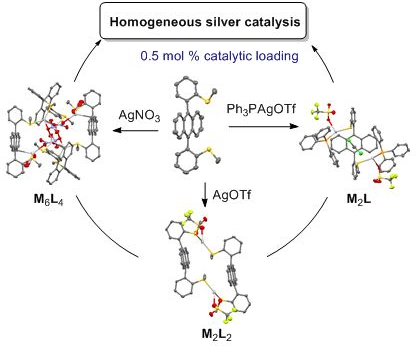Search results
Search for "silver complex" in Full Text gives 9 result(s) in Beilstein Journal of Organic Chemistry.
Formation of alkyne-bridged ferrocenophanes using ring-closing alkyne metathesis on 1,1’-diacetylenic ferrocenes
Beilstein J. Org. Chem. 2019, 15, 2534–2543, doi:10.3762/bjoc.15.246

- can be seen in Figure 9. Single crystals of the silver complex 5 suitable for X-ray diffraction analysis could be obtained after layering a THF solution with hexane. The resulting ORTEP drawing is shown in Figure 10. The molecular structure of 5 turned out to be a coordination polymer with a rather
Self-assembled coordination thioether silver(I) macrocyclic complexes for homogeneous catalysis
Beilstein J. Org. Chem. 2019, 15, 2465–2472, doi:10.3762/bjoc.15.239

- ; homogeneous catalysis; prochiral; silver complex; thioether ligand; Introduction Since the early advances in the late eighties [1][2][3][4][5][6][7][8][9][10], silver(I) catalysis has been widely exploited based on the versatile redox and soft Lewis acid properties of this coinage metal cation. Silver
Small anion-assisted electrochemical potential splitting in a new series of bistriarylamine derivatives: organic mixed valency across a urea bridge and zwitterionization
Beilstein J. Org. Chem. 2019, 15, 2277–2286, doi:10.3762/bjoc.15.220

- . Such N–H···F hydrogen-bond formation was also reported for other urea derivatives with PF6− as counteranion in the solid state [54][55]. The N···F distance of 2.85 Å in 1b+–PF6− is slightly longer than that observed in the crystal structure of a silver complex having a pyridyl urea ligand (2.67 and
Gold-catalyzed ethylene cyclopropanation
Beilstein J. Org. Chem. 2019, 15, 67–71, doi:10.3762/bjoc.15.7
- development of a catalytic route for cyclopropane 1, we have not invested efforts in the characterization of such materials. The silver complex Tp(CF3)2,BrAg(thf) [19] (Table 1, entry 3) was not effective toward the aforementioned target, since only 5% of 1 was formed. In this case, the product derived from
Methylpalladium complexes with pyrimidine-functionalized N-heterocyclic carbene ligands
Beilstein J. Org. Chem. 2016, 12, 1557–1565, doi:10.3762/bjoc.12.150

- -(N,N,N',N'-tetramethyl-1,2-ethylendiamine)palladium(II) [38] were prepared according to literature procedures. Chloro(methyl)(1-(2-pyrimidyl)-3-(tert-butyl)imidazolin-2-ylidene)palladium(II) (9) 0.20 g (0.6 mmol) of the silver complex 5 and 0.16 g (0.6 mmol) chloro(methyl)(cyclooctadiene)palladium(II
- , 4.46%; N, 15.32%. Chloro(methyl)(1-(2-pyrimidyl)-3-(cyclohexyl)imidazolin-2-ylidene)palladium(II) (10) 0.10 g (0.3 mmol) of the silver complex 6 and 0.08 g (0.3 mmol) chloro(methyl)(cyclooctadiene)palladium(II) are dissolved in 30 mL dichloromethane. Under exclusion of light in an argon atmosphere the
- , 13.70%. Chloro(methyl)(1-(2-pyrimidyl)-3-(2,6-diisopropylphenyl)imidazolin-2-ylidene)palladium(II) (11) 0.04 g (0.1 mmol) of the silver complex 7 and 0.03 g (0.1 mmol) chloro(methyl)(cyclooctadiene)palladium(II) are dissolved in 30 mL dichloromethane. Under exclusion of light in an argon atmosphere the
Copper-catalyzed asymmetric conjugate addition of organometallic reagents to extended Michael acceptors
Beilstein J. Org. Chem. 2015, 11, 2418–2434, doi:10.3762/bjoc.11.263
- example of copper-catalyzed selective 1,4-ACA of low-cost trialkylaluminium reagents on extended Michael acceptors in 2008 [39]. The reported catalytic system, featuring Cu(OTf)2 and sulfonated NHC-based silver complex L15 as the ligand source, appeared as the most potent system in the conversion of
Silver and gold-catalyzed multicomponent reactions
Beilstein J. Org. Chem. 2014, 10, 481–513, doi:10.3762/bjoc.10.46

- developed a new saturated 1,3-bis(2,6-diisopropylphenyl)imidazolium (SIPr) silver complex, characterized by the presence of a less bulky acetoxy anion [15]. The new NHC–Ag(I) complex displayed a broad scope in A3-coupling reactions, tolerating alkyl and arylaldehydes (also unactivated ones), cyclic and
Chiral gold(I) vs chiral silver complexes as catalysts for the enantioselective synthesis of the second generation GSK-hepatitis C virus inhibitor
Beilstein J. Org. Chem. 2011, 7, 988–996, doi:10.3762/bjoc.7.111
- -Dipolar cycloaddition of iminoester 6b and tert-butyl acrylate. General procedure. To a solution of the in situ prepared chiral gold complex or chiral silver complex (0.05 mmol) in toluene (2 mL) was added, at r.t., a solution of the iminoester 6b (120 mg, 0.5 mmol) and tert-butyl acrylate (109 μL, 0.75
Novel loop-like aromatic compounds: a further step on the road to nanobelts and nanotubes
Beilstein J. Org. Chem. 2010, 6, No. 30, doi:10.3762/bjoc.6.30
- , two halogenated derivatives and one silver complex, which with reference to the definitions of Scott [1] and Tobe [18], belong to the class of bridged all-Z-[n]annulenes, which are a subclass of loop-like or single-stranded molecules [19]. All structures were characterized by crystal structure
- , hexafluorophosphate and hexafluoroantimonate, silver hexafluoroantimonate gave crystals with 2 on applying the diffusion method with dichloromethane/diethylether (Scheme 2). However, crystals of the corresponding silver complex with 3, suitable for X-ray structural analysis, could not be obtained. A number of
















































































































































